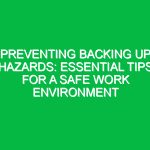Welcome, team! Today, we are going to focus on an important topic that directly impacts our health and safety at work: preventing back injuries. Back injuries are a common occurrence in the workplace, but with the right knowledge and practices, we can significantly reduce the risk of these injuries. Let’s dive into some essential tips for maintaining a healthy workplace and preventing back injuries.
Understanding Back Injuries and Prevention
Back injuries can be debilitating and have a significant impact on our ability to work effectively. In the context of Health, Safety, and Environment (HSE), it is crucial to address the factors that contribute to back injuries and implement preventive measures to ensure a safe working environment for all employees.
Common Causes of Back Injuries
Poor Lifting Techniques: Incorrect lifting techniques, such as bending at the waist or twisting while lifting heavy objects, can strain the muscles and ligaments in the back.
Repetitive Movements: Performing repetitive tasks that involve bending, twisting, or lifting can put undue stress on the back over time.
Sedentary Lifestyle: Prolonged sitting or standing without proper breaks and stretching can lead to muscle stiffness and back pain.
Improper Posture: Maintaining poor posture while sitting or standing can strain the back muscles and lead to long-term issues.
Lack of Exercise: Inadequate physical activity and core strength can make the back more susceptible to injuries.
Best Practices for Preventing Back Injuries
Proper Lifting Techniques: Always bend at the knees, keep the back straight, and lift with the legs when picking up heavy objects.
Use Mechanical Aids: When possible, use equipment like forklifts, dollies, or conveyor belts to move heavy items instead of manual lifting.
Take Regular Breaks: Incorporate short breaks into your workday to stretch, walk around, and relieve the pressure on your back.
Maintain Good Posture: Sit and stand with your back straight, shoulders back, and feet flat on the floor to reduce strain on the back muscles.
Stay Active: Engage in regular exercise routines that strengthen the core muscles and improve flexibility to support a healthy back.
Hazards and Risks Associated with Back Injuries
Identifying potential hazards and risks related to back injuries is essential for creating a safe working environment. By recognizing these risks, we can take proactive steps to mitigate them and prevent accidents in the workplace.
Hazard Identification
– **Heavy Lifting**: Moving heavy objects without proper equipment or assistance can strain the back muscles and lead to injuries.
– **Awkward Postures**: Working in awkward positions that twist or bend the back can cause muscle imbalances and pain.
– **Fatigue**: Working long hours without adequate rest can increase the risk of back injuries due to reduced muscle strength and coordination.
– **Poor Ergonomics**: Using poorly designed workstations or equipment can contribute to back pain and discomfort over time.
Risk Mitigation Strategies
– **Workstation Ergonomics**: Adjust your workstation to promote good posture and reduce strain on the back while working.
– **Training and Education**: Provide training on proper lifting techniques and ergonomic practices to all employees to prevent back injuries.
– **Risk Assessments**: Conduct regular risk assessments to identify potential hazards and implement control measures to minimize the risk of back injuries.
– **Encourage Reporting**: Encourage employees to report any discomfort or pain in their back early on to prevent the escalation of minor issues into more serious injuries.
Practical Tips for Back Injury Prevention
Now that we have covered the key aspects of back injuries and prevention, let’s discuss some practical tips that you can implement in your daily work routine to safeguard your back health.
Daily Practices
– **Stretch Regularly**: Incorporate stretching exercises into your daily routine to improve flexibility and reduce muscle tension in the back.
– **Stay Hydrated**: Drink plenty of water throughout the day to keep your muscles hydrated and prevent stiffness in the back.
– **Use Proper Tools**: Utilize ergonomic tools and equipment that support good posture and reduce strain on the back.
– **Communicate**: If you experience any discomfort or pain in your back, communicate with your supervisor or HSE representative to address the issue promptly.
Team Collaboration
– **Support Each Other**: Offer assistance to your colleagues when lifting heavy objects or performing tasks that may strain the back.
– **Promote Safety Culture**: Encourage a culture of safety within the team where everyone looks out for each other’s well-being and follows best practices for back injury prevention.
Conclusion
In conclusion, preventing back injuries is a shared responsibility that requires awareness, education, and proactive measures from all team members. By implementing the tips and strategies discussed in this Toolbox Talk, we can create a safer and healthier workplace for everyone. Remember, your health and safety are paramount, so let’s work together to prevent back injuries and promote a culture of well-being in our workplace.
Thank you for your attention and commitment to safety. Stay safe and take care of your back!


